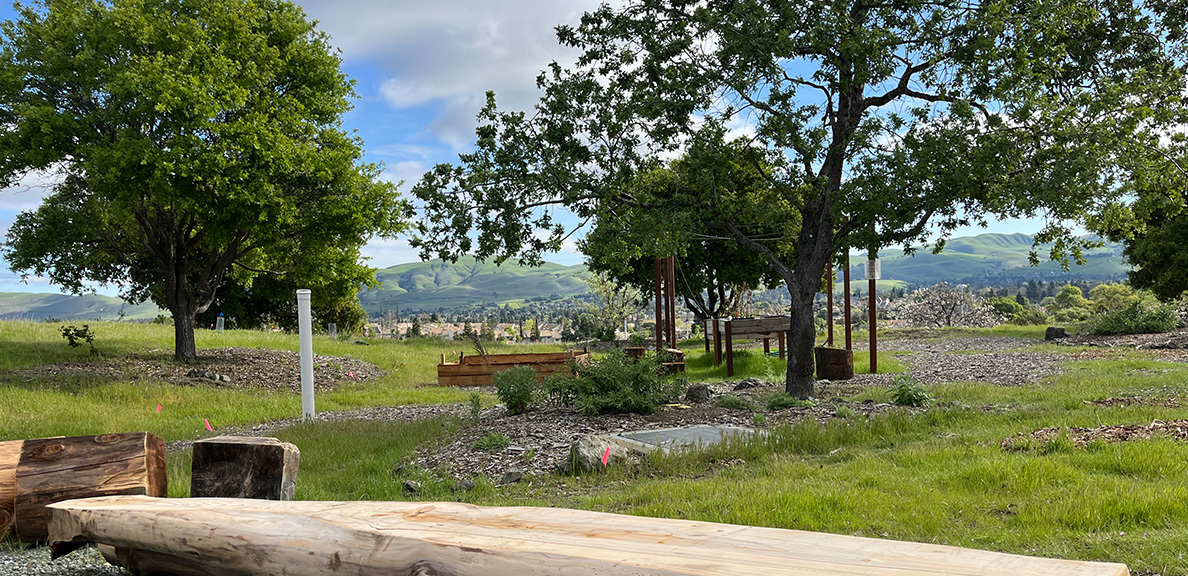
Acknowledging Indigenous Territory: US Environmental Protection Agency Awards the Concord Center A Helpful Grant to Restore and Maintain Its Native Land
BY Elias Barboza
PHOTOGRAPHY BY Kathy Cutting
April 9, 2024
Indigenous Bay Area communities will soon have their own piece of land in Contra Costa County to practice their culture, learn about their history and continue their traditions. This spring, the United State Environmental Protection Agency (EPA) is awarding Cal State East Bay’s Concord Center $916,000 to develop and implement a four-year Climate Resilience Initiative project. The grant will mainly support continuing to build a native plant garden at the Concord Center to promote and sustain Indigenous food sovereignty for the Miwok and Chochenyo Ohlone Tribes. Additionally, the funds will be used for restoration work at CSUEB’s Galindo Creek Field Station and transportation for students, faculty and staff from the Hayward campus to the Concord Center one day per week each semester (fall 2024 - spring 2027) to participate in research and educational activities.
The Concord Center’s vision is for this grant to be a part of a larger effort to improve the creek and garden spaces in order to restore traditional Native land stewardship, and act as a community gathering space for Tribal meetings and educational workshops. Administrative Support Coordinator Kathy Cutting is directing the project, and recently expressed her delight in what this grant means to the Concord Center and its ties with the Indigenous community.
“I’m super excited to have this opportunity and I can’t believe it’s finally happening,” said Cutting. “This is big!”
After establishing the Galindo Creek Field Station in 2018, the National Association of Conservation Districts awarded Cutting with a $50,000 grant in fall 2022 to establish the Wolwonja Ecocultural Garden at the Concord Center. After reading an article about the garden and learning how CSUEB supports the Indigenous community, the EPA contacted Cutting and expressed interest in allocating a grant to the Concord Center.
In addition to financially supporting these large projects, the EPA’s grant has already brought students, staff and faculty to work together. CSUEB’s Nursing department became involved after recognizing this project as an opportunity to improve the students’ mental and physical well-being by engaging with nature. Nursing Assistant Professors Kate Shade and Canyon Steinzig are the grant’s principal investigators who will incorporate the garden into Nursing’s curriculum.
Earth and Environmental Sciences Assistant Professor Patty Oikawa has also joined and will conduct carbon sequestration studies, gathering data on the garden’s air and soil before and during the improvements. Ethnic Studies Professor Enrique Salmon is already using the garden to teach his students about Native agricultural methods, and Anthropology, Geography and Environmental Studies Assistant Professor Tony Marks-Block plans to utilize it in the near future. Diablo Valley College’s horticulture department has also shown interest in partnering with the university, specifically to participate in growing native plants.
“This grant is bringing more of our faculty to the table,” said Cutting. “Everyone has perked up at the possibilities this grant can provide, so we’re getting a lot of engagement.”
In the following weeks, Cutting and her team of volunteer community members will begin planting 50 fruit trees within the garden, initiating Indigenous food production. This will teach students and the community about where their food comes from, how to grow it, what it tastes like, its nutrition benefits and the patience and dedication it takes to grow. Further down the line, Cutting will install rainwater harvesting devices and monitor wildlife.
“The Wolwonja Ecocultural Garden will be further developed using sustainability and climate resilience methods based on Traditional Ecological Knowledge and the vision of the Indigenous communities” said Cutting. “This project will likely become a model of future climate resilience in other ancestral Indigenous lands.”
Share this story